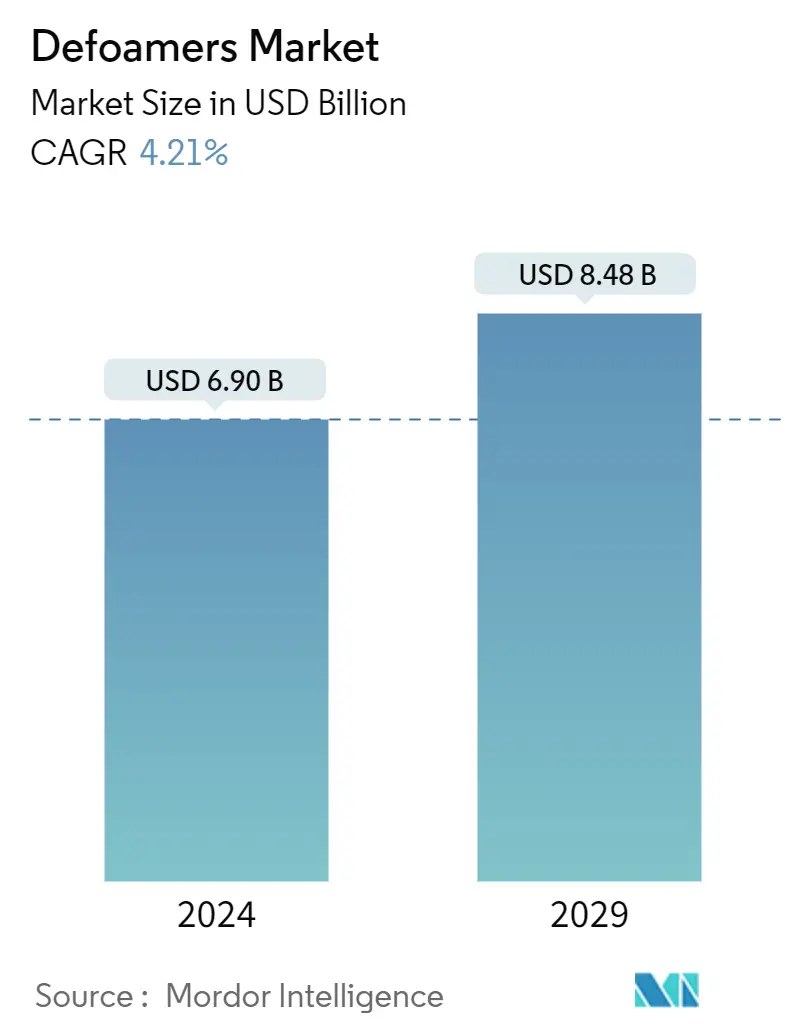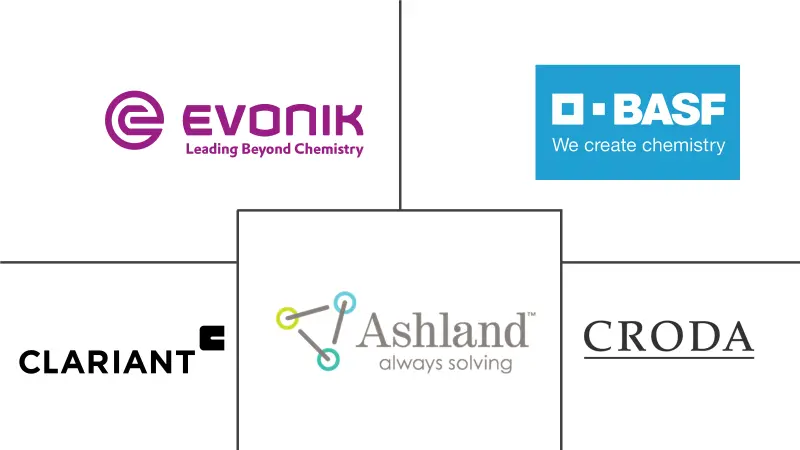
| Study Period | 2019 - 2029 |
| Market Size (2024) | USD 6.90 Billion |
| Market Size (2029) | USD 8.48 Billion |
| CAGR (2024 - 2029) | 4.21 % |
| Fastest Growing Market | Asia Pacific |
| Largest Market | Asia Pacific |
| Market Concentration | Medium |
Major Players
*Disclaimer: Major Players sorted in no particular order |
Defoamers Market Analysis
The Defoamers Market size is estimated at USD 6.90 billion in 2024, and is expected to reach USD 8.48 billion by 2029, growing at a CAGR of 4.21% during the forecast period (2024-2029).
The COVID-19 epidemic harmed the defoamers sector. Global lockdowns and severe rules enforced by governments resulted in a catastrophic setback as most production hubs were shut down. Nonetheless, the business is recovering from 2021 and is expected to rise significantly in the coming years.
- Over the short term, significant growth in the chemical industry worldwide is one of the key factors driving the studied market growth.
- On the flip side, side effects associated with the products are expected to hinder the defoamers' market growth during the forecast period.
- Nevertheless, the rising demand for eco-friendly defoamers will likely create lucrative growth opportunities for the studied market.
- The Asia-Pacific is expected to dominate the market and will also witness the highest CAGR during the forecast period.
Defoamers Industry Segmentation
Defoamers, commonly referred to as anti-foaming agents, are substances that prevent foam from forming during various industrial operations. Defoamer's low viscosity, fast spreading, and low affinity for air-liquid interfaces are some of its essential characteristics. The market is segmented based on type, end-user, and geography. The market is segmented by type into oil-based defoamer, emulsion defoamer, silicone-based defoamer, powder defoamer, polymer-based defoamer, and other types. End-users segment the market into paints and coatings, oil and gas, pulp and paper, food and beverages, water and wastewater treatment, and other end-user industries. The report offers market size and forecasts for 15 countries across major regions. For each segment, market sizing and forecasts are based on revenue (USD) for all the above segments.
| Oil-based Defoamer |
| Emulsion Defoamer |
| Silicone-based Defoamer |
| Powder Defoamer |
| Polymer-based Defoamers |
| Other Types |
| Paints and Coatings |
| Oil and Gas |
| Pulp and Paper |
| Food and Beverages |
| Water and Wastewater Treatment |
| Other End-user Industries |
| Asia-Pacific | China |
| India | |
| Japan | |
| South Korea | |
| ASEAN Countries | |
| Rest of Asia-Pacific | |
| North America | United States |
| Canada | |
| Mexico | |
| Europe | Germany |
| United Kingdom | |
| Italy | |
| France | |
| Rest of Europe | |
| South America | Brazil |
| Argentina | |
| Rest of South America | |
| Middle-East and Africa | Saudi Arabia |
| South Africa | |
| Rest of Middle-East and Africa |
Defoamers Market Size Summary
The defoamers market is poised for significant growth over the forecast period, driven by the recovery from the setbacks caused by the COVID-19 pandemic. The market is experiencing a resurgence due to the expanding chemical industry globally, which is a key factor propelling its growth. However, the market faces challenges from the side effects associated with defoamers, which could hinder its expansion. Despite these challenges, the increasing demand for eco-friendly defoamers presents lucrative opportunities for market players. The Asia-Pacific region is expected to dominate the market, with China and India leading the charge due to their robust industrial activities and urbanization trends.
Defoamers play a crucial role in industrial and municipal wastewater treatment, enhancing production capacity and reducing operational costs by mitigating foam formation. The growing urban population in countries like China and Mexico is driving the demand for improved wastewater treatment solutions, thereby boosting the defoamers market. Additionally, the rising automotive and construction sectors in China further contribute to the demand for defoamers, particularly in paints and coatings applications. The market is moderately consolidated, with major players like BASF SE, Croda International Plc, and Evonik Industries AG leading the industry. Recent product innovations, such as bio-based defoamers, indicate a shift towards more sustainable solutions, aligning with the increasing focus on environmental sustainability.
Defoamers Market Size - Table of Contents
1. MARKET DYNAMICS
-
1.1 Drivers
- 1.1.1 Expansion and adaptability in the chemical industry
- 1.1.2 Increasing Paints and Coatings Production
- 1.1.3 Other Drivers
-
1.2 Restraints
- 1.2.1 Side Effects Associated with the Products
- 1.2.2 Raw Material Shortage and Shipping Delays
- 1.2.3 Other Restraints
- 1.3 Industry Value-chain Analysis
-
1.4 Porter's Five Forces Analysis
- 1.4.1 Bargaining Power of Suppliers
- 1.4.2 Bargaining Power of Buyers
- 1.4.3 Threat of New Entrants
- 1.4.4 Threat of Substitute Products and Services
- 1.4.5 Degree of Competition
2. MARKET SEGMENTATION (Market Size in Value)
-
2.1 Type
- 2.1.1 Oil-based Defoamer
- 2.1.2 Emulsion Defoamer
- 2.1.3 Silicone-based Defoamer
- 2.1.4 Powder Defoamer
- 2.1.5 Polymer-based Defoamers
- 2.1.6 Other Types
-
2.2 End-user Industry
- 2.2.1 Paints and Coatings
- 2.2.2 Oil and Gas
- 2.2.3 Pulp and Paper
- 2.2.4 Food and Beverages
- 2.2.5 Water and Wastewater Treatment
- 2.2.6 Other End-user Industries
-
2.3 Geography
- 2.3.1 Asia-Pacific
- 2.3.1.1 China
- 2.3.1.2 India
- 2.3.1.3 Japan
- 2.3.1.4 South Korea
- 2.3.1.5 ASEAN Countries
- 2.3.1.6 Rest of Asia-Pacific
- 2.3.2 North America
- 2.3.2.1 United States
- 2.3.2.2 Canada
- 2.3.2.3 Mexico
- 2.3.3 Europe
- 2.3.3.1 Germany
- 2.3.3.2 United Kingdom
- 2.3.3.3 Italy
- 2.3.3.4 France
- 2.3.3.5 Rest of Europe
- 2.3.4 South America
- 2.3.4.1 Brazil
- 2.3.4.2 Argentina
- 2.3.4.3 Rest of South America
- 2.3.5 Middle-East and Africa
- 2.3.5.1 Saudi Arabia
- 2.3.5.2 South Africa
- 2.3.5.3 Rest of Middle-East and Africa
Defoamers Market Research FAQs
How big is the Defoamers Market?
The Defoamers Market size is expected to reach USD 6.90 billion in 2024 and grow at a CAGR of 4.21% to reach USD 8.48 billion by 2029.
What is the current Defoamers Market size?
In 2024, the Defoamers Market size is expected to reach USD 6.90 billion.


